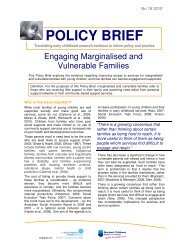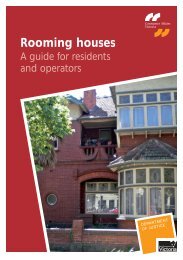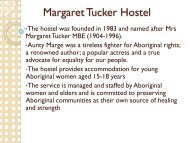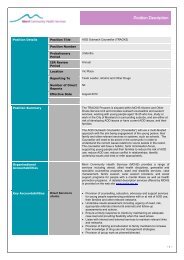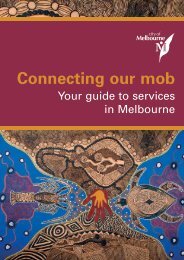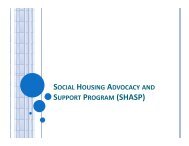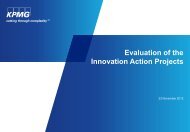Protecting children, changing lives: a new way of working (PDF
Protecting children, changing lives: a new way of working (PDF
Protecting children, changing lives: a new way of working (PDF
You also want an ePaper? Increase the reach of your titles
YUMPU automatically turns print PDFs into web optimized ePapers that Google loves.
<strong>Protecting</strong> <strong>children</strong>, <strong>changing</strong> <strong>lives</strong><br />
A <strong>new</strong> <strong>way</strong> <strong>of</strong> <strong>working</strong>
2 <strong>Protecting</strong> <strong>children</strong>, <strong>changing</strong> <strong>lives</strong><br />
If you would like to receive this publication in another format,<br />
please phone Erin McEvoy on 1300 650 172,<br />
using the National Relay Service 13 36 77 if required,<br />
or email childprotection@dhs.vic.gov.au<br />
This document may also be downloaded from the<br />
Department <strong>of</strong> Human Services website at www.dhs.vic.gov.au<br />
Published by Victorian Government Department <strong>of</strong> Human Services,<br />
Melbourne, Victoria.<br />
November 2012 (0221012)<br />
© Copyright State <strong>of</strong> Victoria, Department <strong>of</strong> Human Services, 2012.<br />
This publication is copyright. No part may be reproduced by any process<br />
except in accordance with the provisions <strong>of</strong> the Copyright Act 1968.<br />
ISBN 978-0-7311-6556-8(print) ISBN 978-0-7311-6557-5(online)<br />
Authorised and published by the Victorian Government, 50 Lonsdale Street, Melbourne.<br />
Print managed by Finsbury Green<br />
Due to privacy considerations, images in this document show models,<br />
and do not necessarily depict actual recipients <strong>of</strong> services.
3<br />
Content<br />
Page<br />
4 Ministerial foreword<br />
6 Background<br />
7 Valuing the work, developing the pr<strong>of</strong>essional<br />
7 New Victorian Public Service (VPS) Enterprise Bargaining Agreement<br />
8 New practice stream<br />
8 Developing the pr<strong>of</strong>essional<br />
9 Beginning Practice<br />
9 Leadership development<br />
9 Child Protection Leadership Program<br />
10 New minimum qualifications<br />
10 Child Protection Student Placement Program<br />
10 Specialist practice resources<br />
10 Recruitment<br />
11 Valuing practice<br />
12 Recognising excellence<br />
12 Improving understanding <strong>of</strong> the court system<br />
13 More support for, and supervision <strong>of</strong> frontline practitioners<br />
13 Strengthening support and supervision<br />
13 Inducting <strong>new</strong> practitioners<br />
14 Supporting evidence informed practice<br />
14 More guidance for practitioners heading to court<br />
15 More practitioners, with more experience, <strong>working</strong> directly with <strong>children</strong><br />
and families<br />
15 Case practice career path<strong>way</strong><br />
15 New investment in frontline staff<br />
15 Practice guidance<br />
15 Multidisciplinary centres<br />
16 Family Group Conferences and Aboriginal Family Decision Making<br />
16 New child protection workforce structure<br />
17 Area based service delivery<br />
18 Reducing the statutory and administrative burden<br />
18 Child Protection Case Practice Manual<br />
18 Client Relationship Information System (CRIS)<br />
19 How will the <strong>new</strong> operating model be evaluated?<br />
19 Victoria’s Vulnerable Children: Our Shared Responsibility
4 <strong>Protecting</strong> <strong>children</strong>, <strong>changing</strong> <strong>lives</strong><br />
Ministerial foreword<br />
The protection and safety <strong>of</strong> vulnerable<br />
<strong>children</strong> and young people is everyone’s<br />
responsibility – government, service providers,<br />
the broader community and individuals.<br />
For its part, the Victorian Government is<br />
undertaking a major overhaul <strong>of</strong> the child<br />
protection system that includes workforce<br />
reform, innovative policies, culture change,<br />
legislation and <strong>new</strong> or expanded programs.<br />
A key component <strong>of</strong> this change is a largescale<br />
restructure <strong>of</strong> the Victorian statutory<br />
child protection workforce – the most<br />
significant workforce reform in more than<br />
three decades.<br />
The <strong>new</strong> child protection operating model<br />
is one <strong>of</strong> three cornerstone projects,<br />
along with the Department <strong>of</strong> Human<br />
Services Organisational Restructure and<br />
Services Connect, which will transform the<br />
Department <strong>of</strong> Human Services, in order to<br />
provide more targeted and joined up services<br />
to vulnerable Victorians.<br />
The <strong>new</strong> operating model puts greater focus<br />
on delivering services at the frontline, and will<br />
ensure services for vulnerable Victorians are<br />
both effective and sustainable into the future.<br />
When first elected, the Coalition Government<br />
asked child protection practitioners what<br />
needed to change in order for them to better<br />
support vulnerable <strong>children</strong>, young people<br />
and families.<br />
Hundreds <strong>of</strong> former and current child<br />
protection staff told us what needed to<br />
be done and this is documented in Child<br />
protection workforce: the case for change<br />
(June 2011).<br />
Many practitioners talked about the<br />
difficulties <strong>of</strong> <strong>working</strong> in a system that was<br />
overly bureaucratic, unsupportive, involved<br />
heavy workloads and lacked career and<br />
learning opportunities.<br />
The case for change was indeed<br />
overwhelming. We acted on this strong body<br />
<strong>of</strong> evidence and devised a plan to transform<br />
the child protection workforce.<br />
In <strong>Protecting</strong> <strong>children</strong>, <strong>changing</strong> <strong>lives</strong> (July<br />
2011) we proposed a <strong>new</strong> operating model<br />
that emphasised the fundamental importance<br />
<strong>of</strong> case practice and aimed to increase<br />
the number <strong>of</strong> frontline staff and improve<br />
supervision, support and co-<strong>working</strong>,<br />
particularly for <strong>new</strong> recruits.<br />
More than 500 child protection practitioners<br />
provided feedback on the proposed operating<br />
model. At the same time, a revised career and<br />
pay structure for practitioners was considered<br />
as part <strong>of</strong> the Victorian Public Service (VPS)<br />
Enterprise Agreement.<br />
We have listened and now we are acting.<br />
<strong>Protecting</strong> <strong>children</strong>, <strong>changing</strong> <strong>lives</strong>: A <strong>new</strong><br />
<strong>way</strong> <strong>of</strong> <strong>working</strong> outlines the details <strong>of</strong> the<br />
<strong>new</strong> operating model for the Victorian child<br />
protection workforce.<br />
The <strong>new</strong> model, which takes effect<br />
immediately, targets four key areas for action:<br />
1. Valuing the work, developing the<br />
pr<strong>of</strong>essional<br />
2. More support for, and supervision <strong>of</strong><br />
frontline practitioners<br />
3. More practitioners, with more experience,<br />
<strong>working</strong> directly with <strong>children</strong> and families<br />
4. Reducing the statutory and administrative<br />
burden.<br />
The details <strong>of</strong> the changes are outlined in<br />
the following pages, but essentially it will<br />
increase the percentage <strong>of</strong> the workforce who<br />
are directly involved with <strong>children</strong> and young<br />
people from 63 per cent to 75 per cent.
5<br />
It gives greater recognition to the specialist<br />
work <strong>of</strong> a pr<strong>of</strong>essional child protection<br />
practitioner and provides a clear career<br />
path<strong>way</strong> for experienced practitioners who<br />
stay in the practice stream.<br />
A <strong>new</strong> team structure will give practitioners<br />
more support and more opportunities<br />
for reflective supervision, mentoring and<br />
pr<strong>of</strong>essional development.<br />
The <strong>new</strong> operating model seeks to change<br />
the workplace culture to one where the views<br />
<strong>of</strong> all practitioners, regardless <strong>of</strong> status and<br />
position, are listened to and valued. Frontline<br />
practitioners will have greater decision-making<br />
authority, freeing up time for managers to<br />
improve the quality <strong>of</strong> practice.<br />
More opportunities for training and learning<br />
and clear career path<strong>way</strong>s will help to build<br />
the skills capacity <strong>of</strong> the workforce and<br />
improve recruitment and retention rates.<br />
We know that a skilled and well-supported<br />
workforce is best placed to respond quickly<br />
and effectively to the complex needs <strong>of</strong><br />
vulnerable <strong>children</strong> and young people.<br />
I am pleased to present this <strong>new</strong> operating<br />
model for the Victorian child protection<br />
workforce, and look forward to <strong>working</strong> with you<br />
to improve the safety and wellbeing <strong>of</strong> Victoria’s<br />
most vulnerable <strong>children</strong> and young people.<br />
The case for change was indeed<br />
overwhelming. We acted on this strong body<br />
<strong>of</strong> evidence and devised a plan to transform<br />
the child protection workforce.<br />
Hon Mary Wooldridge MP<br />
Minister for Community Services
6 <strong>Protecting</strong> <strong>children</strong>, <strong>changing</strong> <strong>lives</strong><br />
Background<br />
In June 2011, the Victorian Government released<br />
a document articulating a case for change in the<br />
statutory child protection workforce.<br />
The content <strong>of</strong> the document was informed<br />
by the views <strong>of</strong> hundreds <strong>of</strong> former and<br />
current child protection practitioners, and<br />
outlined the systemic problems that made it<br />
difficult for practitioners to consistently provide<br />
quality services.<br />
“It was clear that the operating model that<br />
had evolved over three decades needed<br />
significant reform.”<br />
At that time, one in four <strong>new</strong> practitioners<br />
was leaving the pr<strong>of</strong>ession every year, and<br />
it was clear that the operating model that<br />
had evolved over three decades needed<br />
significant reform.<br />
<strong>Protecting</strong> <strong>children</strong>, <strong>changing</strong> <strong>lives</strong>:<br />
supporting the child protection workforce<br />
was subsequently released in July 2011, and<br />
outlined a comprehensive plan for a <strong>new</strong><br />
and significantly transformed child protection<br />
operating model.<br />
The plan included overhauling roles, duties,<br />
decision-making authority and delegations.<br />
It advocated a re<strong>new</strong>ed focus on the<br />
fundamental importance <strong>of</strong> case practice;<br />
increased staff <strong>working</strong> directly with <strong>children</strong>;<br />
and better support for practitioners.<br />
The <strong>Protecting</strong> <strong>children</strong>, <strong>changing</strong> <strong>lives</strong><br />
blueprint formed the basis for negotiations<br />
with staff and their representatives as part <strong>of</strong><br />
the Victorian Public Service (VPS) enterprise<br />
agreement process.<br />
In July 2012, the enterprise agreement was<br />
formally ratified with the introduction <strong>of</strong> the<br />
<strong>new</strong> child protection operating model in<br />
November 2012.
7<br />
Valuing the work, developing the pr<strong>of</strong>essional<br />
The <strong>new</strong> child protection operating model is<br />
designed to give practitioners the support and<br />
flexibility needed to deliver better outcomes<br />
for vulnerable <strong>children</strong> and young people.<br />
The <strong>new</strong> model gives greater recognition to<br />
the specialist work <strong>of</strong> a pr<strong>of</strong>essional child<br />
protection practitioner and provides a clear<br />
career path<strong>way</strong> for experienced practitioners<br />
who wish to stay in practice.<br />
It aims to change the workplace culture,<br />
valuing the contribution <strong>of</strong> all pr<strong>of</strong>essional staff<br />
regardless <strong>of</strong> status and position. A more<br />
consultative approach to decision-making -<br />
where fresh eyes are brought in at critical points<br />
- will enhance the quality <strong>of</strong> those decisions.<br />
The daily pressures <strong>of</strong> the job will be eased<br />
with more opportunities for debriefing and<br />
more co-<strong>working</strong>, mentoring and supervision<br />
provided by experienced practitioners.<br />
The revised career structure provides more<br />
leadership roles and opportunities for<br />
continued learning and development. This will<br />
help build the experience within the workforce<br />
while maintaining a strong focus on delivering<br />
best practice.<br />
The operating model is based upon a<br />
<strong>new</strong> classification structure for Children,<br />
Youth and Family staff. The existing Child<br />
Protection Worker (CPW 1-6) classification<br />
has been replaced by a <strong>new</strong> Child Protection<br />
Practitioner (CPP 2-6) classification.<br />
Most existing child protection staff directly<br />
transitioned to these <strong>new</strong> classifications.<br />
A number <strong>of</strong> <strong>new</strong> positions have been<br />
created including senior child protection<br />
practitioners (supervisory and nonsupervisory,<br />
community-based and court<br />
<strong>of</strong>ficer), team manager, practice leader, area<br />
manager and deputy area manager.<br />
New Victorian Public Service<br />
(VPS) Enterprise Bargaining<br />
Agreement<br />
The <strong>new</strong> operating model for the child<br />
protection workforce was agreed as part <strong>of</strong><br />
the VPS Enterprise Bargaining Agreement<br />
formally ratified in July 2012.<br />
“Clearly the knowledge and skills <strong>of</strong> experienced frontline workers, who feel<br />
supported and valued and who have an ongoing commitment to their work,<br />
are (or would be) assets <strong>of</strong> immeasurable value in child protection.”<br />
(Source: Healy, K, Meagher G and Cullin J, Retaining Novices to Become Expert Child Protection practitioners: Creating Career Path<strong>way</strong>s in<br />
Direct Practice, British Journal <strong>of</strong> Social Work, (2009)
8 <strong>Protecting</strong> <strong>children</strong>, <strong>changing</strong> <strong>lives</strong><br />
The key activities <strong>of</strong> the <strong>new</strong> positions are:<br />
Senior child protection practitioner<br />
– generally reports to the team manager<br />
and undertakes casework and provides<br />
mentoring and formal supervision <strong>of</strong> up to<br />
two practitioners, including supporting <strong>new</strong><br />
practitioners through the induction program<br />
(CPP 5.1).<br />
Team manager – reports to the area<br />
manager or deputy area manager and is<br />
responsible for managing a team <strong>of</strong> about<br />
seven practitioners, including advanced<br />
practitioners and a senior practitioner. They<br />
are also responsible for monitoring team<br />
performance, exercising key case planning<br />
delegations and the allocation <strong>of</strong> cases and<br />
tasks (CPP 5).<br />
Practice leader – reports to the area<br />
manager, undertakes complex casework,<br />
provides practice leadership and supervises<br />
one or more senior child protection<br />
practitioners (CPP 5.2).<br />
Area manager – reports to the child<br />
protection manager and provides strategic<br />
leadership for the child protection area,<br />
including service planning, case planning,<br />
reviews, briefings and liaison with Child and<br />
Family Information Referral and Support<br />
Teams (Child FIRST) and other service<br />
organisations (CPP 6.1).<br />
Principal practitioner – reports to the<br />
<strong>children</strong>, youth and families manager and<br />
undertakes casework, mentoring and support<br />
to practitioners. This is not a <strong>new</strong> position but<br />
under the <strong>new</strong> operating model there will be<br />
eight principal practitioners (CPP 6) and three<br />
statewide principal practitioners.<br />
In addition to these <strong>new</strong> positions, there are<br />
eight 12-month high risk infant positions that<br />
will work closely with staff to build skills and<br />
knowledge on <strong>working</strong> with high risk infants.<br />
Most staff transitioned to these <strong>new</strong> positions<br />
via an Expression <strong>of</strong> Interest process.<br />
The <strong>new</strong> classification aligns child protection<br />
staff with the VPS Grades and related salary<br />
structure. The starting salary for graduates<br />
has increased to $57,508 up from $49,873<br />
and practitioners have an additional one-week<br />
annual leave and improved conditions.<br />
Some further change to senior staff reporting<br />
arrangements will occur when the <strong>new</strong><br />
Department <strong>of</strong> Human Services organisational<br />
structure takes effect.<br />
New practice stream<br />
Critical to the success <strong>of</strong> the <strong>new</strong> operating<br />
model is the <strong>new</strong> team structure and<br />
practice stream.<br />
Child protection will continue to operate on<br />
a team basis that puts case practice at the<br />
centre <strong>of</strong> work with <strong>children</strong>, young people<br />
and families. The practice stream comprises<br />
child protection practitioners, advanced<br />
child protection practitioners, senior child<br />
protection practitioners, practice leaders and<br />
principal practitioners.<br />
Senior child protection practitioners,<br />
practice leaders and principal practitioners<br />
provide practice guidance, co-<strong>working</strong><br />
and strengthened support to <strong>new</strong> or less<br />
experienced practitioners. All practice<br />
positions include a direct case-carrying<br />
component. The practitioners operating in<br />
the practice stream will help build a learning<br />
culture and a shared approach to complex<br />
case decisions.<br />
Developing the pr<strong>of</strong>essional<br />
The <strong>new</strong> child protection operating model<br />
will ensure that the pr<strong>of</strong>essionalism <strong>of</strong> child<br />
protection practitioners is formally recognised<br />
through a series <strong>of</strong> <strong>new</strong> learning and<br />
development opportunities and the provision<br />
<strong>of</strong> resources promoting best practice.<br />
All child protection practitioners receive<br />
pr<strong>of</strong>essional development training to help<br />
them transition to the <strong>new</strong> operating model.
9<br />
Beginning Practice<br />
All practitioners <strong>new</strong> to the Victorian child<br />
protection program undertake extensive<br />
pr<strong>of</strong>essional development in the first six<br />
months <strong>of</strong> practice, including the 17 day<br />
Beginning Practice child protection program.<br />
Leadership development<br />
Child protection practitioners and their<br />
managers play a vital leadership role in<br />
creating and maintaining cultural change<br />
within the child protection workforce.<br />
Good supervision and leadership supports<br />
practitioners to make good decisions in<br />
a complex environment and contributes<br />
to a stable, more confident and<br />
competent workforce.<br />
Under the <strong>new</strong> operating model there will be an<br />
increase in the number <strong>of</strong> practitioners who take<br />
on leadership roles and who have supervisory<br />
and decision-making responsibilities.<br />
Transitional training has been designed for<br />
those more senior practitioners taking on<br />
<strong>new</strong> roles along with refresher training in case<br />
planning and recording, sexual abuse forensic<br />
interviewing and providing effective supervision.<br />
The Child Protection Leadership Development<br />
Strategy will be further developed to improve<br />
the supervisory, leadership skills and decisionmaking<br />
<strong>of</strong> managers as they transition from<br />
experienced practitioners to <strong>new</strong> supervisors.<br />
As part <strong>of</strong> the strategy, more than 150 child<br />
protection managers have successfully<br />
undertaken ten hours <strong>of</strong> pr<strong>of</strong>essional coaching<br />
with programs set to continue in 2013.<br />
The operating model will also provide managers<br />
with more opportunities for debriefing, learning<br />
and development <strong>of</strong> staff at all levels.<br />
Child Protection Leadership<br />
Program<br />
Senior child protection practitioners, team<br />
managers and practice leaders will participate<br />
in a <strong>new</strong> Child Protection Leadership Program<br />
beginning in 2013.<br />
Entitled Leading practice, managing people, the<br />
program will build capacity in supervisory and<br />
leadership skills, business acumen and decisionmaking,<br />
as experienced practitioners become<br />
senior practitioners and team managers.<br />
With its emphasis on collaboration and joint<br />
decision-making, the leadership program<br />
will equip managers to focus on improving<br />
the quality <strong>of</strong> business and practice support<br />
available to staff.<br />
The 2009 leading practice guide has been<br />
re-written to support the <strong>new</strong> operating model<br />
and the second edition will be published in<br />
late 2012.<br />
“The link between the leadership literature, <strong>working</strong> with emotions and<br />
supervision practice is explored in an extremely useful guide for frontline<br />
and middle managers produced in Australia by the Victorian Government<br />
Department <strong>of</strong> Human Services 1 ...”<br />
(Source: Jane Wonnacott Mastering Social Work Supervision (UK, 2012, p31))<br />
1. Leading practice A resource guide for Child Protection frontline and middle managers (Gibbs, J, Dwyer, J and Vivekananda, K,<br />
Victorian Department <strong>of</strong> Human Services, 2009).
10 <strong>Protecting</strong> <strong>children</strong>, <strong>changing</strong> <strong>lives</strong><br />
New minimum qualifications<br />
To further increase the skills base <strong>of</strong> the<br />
child protection workforce, <strong>new</strong> minimum<br />
qualifications have been set out for entrylevel<br />
practitioners.<br />
The requirements are designed to ensure<br />
that practitioners starting out have a<br />
thorough, specialist knowledge <strong>of</strong> child<br />
welfare and the ability to exercise legal<br />
delegations under the Children, Youth and<br />
Families Act (2005).<br />
Implemented in August 2011, all <strong>new</strong><br />
practitioners need to have completed an<br />
approved course in either social work or<br />
another relevant qualification, including<br />
psychology courses accredited by the<br />
Australian Psychology Accreditation Council.<br />
The list <strong>of</strong> approved qualifications is reviewed<br />
annually to maintain quality assurance<br />
standards and to continue building a highly<br />
skilled, pr<strong>of</strong>essional workforce.<br />
Child Protection Student<br />
Placement Program<br />
Student work placements play an important<br />
role in encouraging and preparing the next<br />
generation <strong>of</strong> child protection practitioners.<br />
In partnership with education providers, the<br />
Child Protection Student Placement Program<br />
has been enhanced to attract and recruit<br />
more students into the pr<strong>of</strong>ession.<br />
As the minimum qualifications include<br />
psychology graduates, student placements for<br />
psychology students will be piloted in 2013.<br />
The placement program educates and<br />
prepares students interested in a career in<br />
child protection.<br />
Specialist practice resources<br />
Three additional resources based on the Best<br />
Interests Case Practice Model have been<br />
designed to promote a common language<br />
around risk assessment. The <strong>new</strong> resources are<br />
the Child and Family Snapshot, Family Snapshot<br />
and Analysis and Risk Assessment Snapshot.<br />
These resources will enable practitioners<br />
to work collaboratively and transparently<br />
with <strong>children</strong> and families as well as guide<br />
discussions with supervisors.<br />
Recruitment<br />
The recruitment <strong>of</strong> quality child protection<br />
practitioners is a critical factor in determining<br />
case outcomes.<br />
A targeted, evidence-based and engaging<br />
marketing campaign has been designed to<br />
attract <strong>new</strong> recruits and encourage experienced<br />
child protection practitioners who may have left<br />
the system back into the workforce.<br />
The campaign, Rewrite tomorrow, one child<br />
at a time, uses search engine marketing and<br />
social media, as well as online and more<br />
traditional forms <strong>of</strong> advertising. It also uses<br />
direct marketing to students studying to<br />
acquire eligible qualifications.<br />
A dedicated child protection recruitment<br />
website provides a one-stop shop for those<br />
interested in a career in child protection.<br />
A short video depicts the day in the life <strong>of</strong><br />
a child protection practitioner.<br />
A streamlined recruitment process has also<br />
been designed to filter candidates who are<br />
best suited for the important role <strong>of</strong> protecting<br />
vulnerable <strong>children</strong> and young people in Victoria.
11<br />
Valuing practice<br />
Public affirmation <strong>of</strong> the importance <strong>of</strong><br />
the work carried out by child protection<br />
practitioners can have a positive impact on<br />
staff retention and morale. It can also foster<br />
a better understanding <strong>of</strong> the work and raise<br />
the issue <strong>of</strong> child protection more broadly. In<br />
Victoria, good practice in child protection and<br />
child and family services is celebrated in a<br />
variety <strong>of</strong> <strong>way</strong>s.<br />
Each year the department publishes Good<br />
practice – a statewide snapshot with<br />
contributions from practitioners, academics,<br />
carers and young people. This inspiring<br />
publication tells <strong>of</strong> the courage and despair<br />
<strong>of</strong> vulnerable <strong>children</strong> and the difference that<br />
frontline practitioners can make to their <strong>lives</strong>.<br />
Dear Heidi,<br />
I want to thank you for everything you have done for me. Things in my <strong>new</strong> place are going great. I’m up to date with all<br />
my bills and rent. I’m still doing TAFE and I have applied for a job at Safe<strong>way</strong>. Mum and I aren’t talking and I think that it<br />
has got to the point that me and Mum are never going to get along. I’ve finally finished my YJ [Youth Justice] order and<br />
I haven’t <strong>of</strong>fended since. Megan finishes with me in 2 weeks and it’s been hard to let go and move into the world on<br />
my own. I’ve found it so hard without you. I sit on the couch at night and wish that I could just call you. You have been<br />
a very big part in my life. I felt like you were a mother to me even though I know you were my worker. If it wasn’t for you<br />
I wouldn’t be where I am today. Adrian and I are living together now. He helps out with food and bills. We have been<br />
together for almost 4 months now. I remember when you used to al<strong>way</strong>s find me wherever I went. To be honest if it<br />
wasn’t for you I wouldn’t be alive right now. I was in the area a while ago and I went into the DHS <strong>of</strong>fice to say hi to you,<br />
but I don’t think you were there.<br />
I wasn’t sure if I could call you or write to you, and then Megan said that I could send cards and letters to you. We didn’t<br />
get to say goodbye properly on my birthday. My hair is now blonde and purple. I miss you heaps Heidi. It’s been so hard.<br />
I’ve felt like everything came around far too quickly. I just wish that it didn’t go so fast. I will al<strong>way</strong>s remember all the fun,<br />
crazy and stressful times we had. All the times when I hung up on you and you would just call back straight a<strong>way</strong><br />
on either my phone or my mate’s phone and I would say, ‘How the fuck did you get this number’.<br />
I remember when I first met you at the train station and we went to Maccas to wait and find out where I was staying, then<br />
3 years later I end up staying at the same place as the first time I met you. Any<strong>way</strong>, enough about me. How have you<br />
been? How is work going? What are you up to this Easter? I don’t know if you are allowed to call me. This is my number.<br />
Any<strong>way</strong> I thought I would write to you and let you know how everything is going. I hope to hear from you soon.<br />
Lots <strong>of</strong> love,<br />
Cathleen oxoxoxo<br />
P.S. Happy Mother’s Day<br />
(Source: Good practice: a statewide snapshot 2012 – Department <strong>of</strong> Human Services)
12 <strong>Protecting</strong> <strong>children</strong>, <strong>changing</strong> <strong>lives</strong><br />
Recognising excellence<br />
The Department <strong>of</strong> Human Services hosts<br />
two annual award ceremonies to celebrate<br />
the work <strong>of</strong> the child protection workforce and<br />
the child, youth and family service sector.<br />
The Robin Clark Memorial Awards, held each<br />
year in Child Protection Week, recognise<br />
excellence in service provision and leadership<br />
in the child and family sector. The awards are<br />
named after Robin Dennis Clark (1936–2001),<br />
a widely respected, inspirational leader in the<br />
field <strong>of</strong> child, youth and family welfare.<br />
The <strong>Protecting</strong> Children Awards are also held<br />
during Child Protection Week and recognise<br />
child protection practitioners who have shown<br />
outstanding leadership in engaging families,<br />
supporting <strong>new</strong> practitioners, supervising<br />
students and excellence in case practice.<br />
Improving understanding <strong>of</strong> the<br />
court system<br />
Working with Victoria’s court system can be a<br />
complex and time consuming part <strong>of</strong> a child<br />
protection practitioner’s work.<br />
A number <strong>of</strong> reforms to improve the<br />
operation <strong>of</strong> the Children’s Court and the<br />
<strong>way</strong> practitioners work with each other<br />
and the legal pr<strong>of</strong>essional in a court setting<br />
are currently under<strong>way</strong>. These form a key<br />
component <strong>of</strong> the Victorian Government’s<br />
response to the <strong>Protecting</strong> Victoria’s<br />
Vulnerable Children Inquiry report.<br />
Additionally, several joint training opportunities<br />
have been held between child protection<br />
practitioners and the legal pr<strong>of</strong>ession,<br />
including the Children’s Court Magistrates<br />
and staff, Victoria Legal Aid and private legal<br />
practitioners.<br />
A recent two-day conference attended<br />
by 250 people provided an opportunity<br />
for information sharing, skill development<br />
and relationship building between the<br />
pr<strong>of</strong>essions. There has also been a forum on<br />
child development and trauma, a workshop<br />
on court skills and a series <strong>of</strong> 15 one-day<br />
workshops centred on the child protection<br />
best interests model.<br />
These events not only increase understanding<br />
<strong>of</strong> court procedures but also promote good<br />
relations and more collaboration between<br />
those who carry out work for the department<br />
and families in the Children’s Court.<br />
Cameron Reid from Hume Region at the 2012<br />
<strong>Protecting</strong> Children Awards.
13<br />
More support for, and supervision <strong>of</strong><br />
frontline practitioners<br />
Strengthening support and<br />
supervision<br />
The <strong>new</strong> child protection operating model will<br />
consolidate a more supportive environment<br />
for child protection practitioners so they can<br />
concentrate on their important work with<br />
vulnerable <strong>children</strong>, young people and families.<br />
Senior child protection practitioners, practice<br />
leaders and principal practitioners will provide<br />
more practice leadership and expert guidance<br />
for <strong>new</strong> or less experienced staff.<br />
Senior case carrying practitioners will model<br />
best practice in building a child-focussed,<br />
family-centred practice culture that integrates<br />
evidence from research and critical reflection.<br />
Senior child protection practitioners will<br />
provide more supervision <strong>of</strong> beginning<br />
practitioners, as well as facilitating regular<br />
opportunities to debrief and seek direction on<br />
the best <strong>way</strong> forward.<br />
The <strong>new</strong> model will help shape the practice<br />
culture to encourage more constructive<br />
feedback and continual learning opportunities<br />
for team members.<br />
Surveys <strong>of</strong> staff have highlighted the<br />
importance <strong>of</strong> being able to have pr<strong>of</strong>essional<br />
conversations without fearing their own<br />
expertise was being called into question.<br />
Senior practitioners will actively encourage<br />
fresh ideas, different views and opinions to<br />
improve critical case planning and decisionmaking<br />
processes.<br />
This ethos has been embedded throughout<br />
the <strong>new</strong> operating model.<br />
Inducting <strong>new</strong> practitioners<br />
New child protection practitioners require<br />
specific training and support in the initial<br />
stages <strong>of</strong> <strong>working</strong> with vulnerable <strong>children</strong> and<br />
young people.<br />
A consistent, thorough and effective induction<br />
process, tailored to meet the needs <strong>of</strong> <strong>new</strong><br />
recruits, has been gradually strengthened and<br />
improved over the past few years.<br />
The Beginning Practice program has been<br />
designed to provide foundation learning for<br />
practitioners <strong>new</strong> to the child protection<br />
workforce at every level.<br />
It will give staff beginning their practice a better<br />
understanding <strong>of</strong> the nature <strong>of</strong> the work and<br />
the <strong>new</strong> operating environment.<br />
The program involves structured activities to<br />
assist <strong>new</strong> practitioners develop the necessary<br />
skills and knowledge as well as opportunities to<br />
work alongside more experienced practitioners.<br />
“Increased use <strong>of</strong> reflective practice, supervision, ongoing and collaborative<br />
peer support may be useful in promoting resilience in child protection staff, by<br />
strengthening workers’ sense <strong>of</strong> control, fostering their commitment through<br />
valuing client-related work and helping them to manage more successfully.”<br />
(Source: Russ, Erica, Lonne, Bob, & Darlington, Yvonne (2009) Using resilience to reconceptualise child protection workforce capacity.<br />
Australian Social Work: The Journal <strong>of</strong> the Association <strong>of</strong> Social Workers, 62(3), pp. 324-338.)
14 <strong>Protecting</strong> <strong>children</strong>, <strong>changing</strong> <strong>lives</strong><br />
Supporting evidence informed<br />
practice<br />
Under the <strong>new</strong> operating model, the Best<br />
Interests principles <strong>of</strong> the Children, Youth and<br />
Families Act 2005, are applied to promote<br />
positive outcomes for vulnerable <strong>children</strong>,<br />
young people and families.<br />
The principles require practitioners to protect<br />
<strong>children</strong> and young people from harm while<br />
respecting their rights and promoting their<br />
learning and development and cultural identity.<br />
The principles recognise the central<br />
importance <strong>of</strong> a child’s family context and the<br />
difference that practitioners, extended families<br />
and communities can make to <strong>children</strong> and<br />
young people’s <strong>lives</strong>.<br />
These principles have informed the<br />
development <strong>of</strong> more detailed child protection<br />
policies, practice guidelines and procedures.<br />
Fig 1. Best Interests Case Practice Model<br />
Reviewing outcomes<br />
Empower<br />
Information gathering<br />
Build relationships<br />
More guidance for practitioners<br />
heading to court<br />
Practitioners preparing cases for the Children’s<br />
Court need to be able to present evidence<br />
that shows the effects <strong>of</strong> harm on <strong>children</strong> and<br />
young people and future risks to their safety,<br />
stability and development.<br />
The court will also want to know the rationale<br />
for pr<strong>of</strong>essional judgments and decisionmaking,<br />
what assistance has been provided<br />
to the family and the outcomes <strong>of</strong> previous<br />
interventions, all supported by evidence.<br />
A Court Kit to assist Victorian child protection<br />
practitioners with the processes, procedures<br />
and legal and practice requirements associated<br />
with applications to the Children’s Court and<br />
related jurisdictions is currently being updated<br />
and will be available in late 2012. The Court Kit<br />
has been designed to act as a checklist that<br />
child protection practitioners utilise to assist in<br />
the preparation <strong>of</strong> applications to the Children’s<br />
Court and related higher jurisdictions.<br />
Preparation for court increases the likelihood<br />
<strong>of</strong> a timely final outcome that benefits <strong>children</strong><br />
and young people in securing their future<br />
planning. It may also increase the chances<br />
<strong>of</strong> consensus being reached with the family<br />
and help maintain a good <strong>working</strong> relationship<br />
following court action.<br />
Actions<br />
Partner<br />
Engage<br />
Analysis and planning
15<br />
More practitioners, with more experience,<br />
<strong>working</strong> directly with <strong>children</strong> and families<br />
Case practice career path<strong>way</strong><br />
For the first time, the <strong>new</strong> operating model<br />
introduces a clear career path<strong>way</strong> for staff<br />
that may want to stay in child protection case<br />
practice. One <strong>of</strong> the major benefits <strong>of</strong> the<br />
<strong>new</strong> career path<strong>way</strong> will be an increase in the<br />
number <strong>of</strong> experienced case carrying staff<br />
<strong>working</strong> directly with families.<br />
The <strong>new</strong> case practice career path<strong>way</strong> will<br />
result in a substantial increase in the number<br />
<strong>of</strong> experienced practitioners who stay in<br />
critical case practice roles. Under the <strong>new</strong><br />
case practice career path<strong>way</strong>, the number<br />
<strong>of</strong> experienced case carrying staff <strong>working</strong><br />
directly with <strong>children</strong> and families will increase<br />
from 63 to 75 per cent.<br />
Many <strong>of</strong> these staff have extensive experience<br />
and will provide an immediate boost to the level<br />
<strong>of</strong> experience among the frontline workforce.<br />
New investment in frontline staff<br />
Investing in the recruitment <strong>of</strong> more frontline<br />
child protection practitioners is a key priority<br />
<strong>of</strong> the <strong>new</strong> child protection operating model.<br />
Since 2011, an additional 89 child protection<br />
positions have been funded, including 42<br />
child protection staff in the 2012-13 budget,<br />
to help meet growing service demands.<br />
The <strong>new</strong> positions are being allocated to meet<br />
the areas <strong>of</strong> highest need.<br />
Practice guidance<br />
To further support frontline practitioners, eight<br />
<strong>new</strong> principal practitioners, with extensive<br />
experience in child protection work, have<br />
been funded to work across Victoria.<br />
A principal practitioner will provide practice<br />
leadership and support practitioners<br />
dealing with highly complex and challenging<br />
cases. They will work closely with teams to<br />
provide specific case advice and share their<br />
knowledge throughout the team.<br />
Case practice capabilities will be increased<br />
through the involvement <strong>of</strong> principal<br />
practitioners in case practice guidance, case<br />
planning, mentoring and supervision.<br />
As a result, more highly experienced staff will<br />
be able to stay in the field and retain their<br />
primary focus on developing child protection<br />
practitioner expertise.<br />
Multidisciplinary centres<br />
Children and young people who have<br />
experienced sexual assault will receive more<br />
targeted support with the establishment <strong>of</strong> three<br />
more multidisciplinary centres in Bendigo, the<br />
Latrobe Valley and the south-east corridor <strong>of</strong><br />
Melbourne. These are in addition to the existing<br />
centres – in Frankston, Geelong and Mildura.<br />
Multidisciplinary centres co-locate specialist<br />
police investigators, child protection<br />
practitioners and sexual assault counsellors<br />
in order to provide an integrated response to<br />
victims <strong>of</strong> sexual assault from a single location.<br />
“Relationships are central to good practice – relationships that engage people in<br />
change, build on strengths and creatively look for solutions in partnership with<br />
families, and that are characterised by respectful communication and wise use<br />
<strong>of</strong> authority.”<br />
(Source: Miller, R 2009, ‘Engagement with families involved in the statutory system’, in J. Maidment & R. Egan (Eds), Practice Skills in Social<br />
Work and Welfare: More than just common sense, 2nd Edition, Allen & Unwin Sydney.)
16 <strong>Protecting</strong> <strong>children</strong>, <strong>changing</strong> <strong>lives</strong><br />
They <strong>of</strong>fer a holistic response to victims <strong>of</strong><br />
sexual assault, child abuse and their families<br />
in an effort to minimise further trauma.<br />
The multidisciplinary centres aim to:<br />
• improve and integrate the investigation <strong>of</strong><br />
sexual <strong>of</strong>fences and child abuse<br />
• improve the quality <strong>of</strong> evidence in sexual<br />
<strong>of</strong>fences and child abuse cases<br />
• improve support for victims<br />
• increase the reporting <strong>of</strong> sexual <strong>of</strong>fences<br />
and reduce attrition<br />
• improve the capacity <strong>of</strong> agencies to work<br />
collaboratively.<br />
Family Group Conferences and<br />
Aboriginal Family Decision Making<br />
Evidence shows that involving families and<br />
extended families in the protection <strong>of</strong> <strong>children</strong><br />
can reduce incidents <strong>of</strong> abuse or neglect.<br />
In recent years, Family Group Conferences<br />
(FGC) and Aboriginal Family Decision Making<br />
(AFDM) have proven effective in delivering better<br />
outcomes for <strong>children</strong> and young people.<br />
In particular, they have been shown to<br />
improve information gathering, strengthen the<br />
child protection response and minimise the<br />
re-reporting <strong>of</strong> cases to authorities.<br />
Previously convened at varying phases <strong>of</strong> child<br />
protection involvement additional funding for<br />
both AFDM and FGC has been provided to<br />
ensure a conference is held for all <strong>children</strong><br />
and young people following substantiation<br />
<strong>of</strong> abuse. In addition an AFDM will be held<br />
to develop and review the case plan for all<br />
Aboriginal <strong>children</strong> subject to a statutory order.<br />
The conferences involve specially trained<br />
departmental and Aboriginal Community<br />
Controlled Organisations (ACCO) convenors<br />
and child protection practitioners meeting with<br />
family members to discuss their concerns about<br />
the child and assisting them to make decisions<br />
that will support the child’s safety and wellbeing.<br />
The expanded use <strong>of</strong> family conferences aims<br />
to strengthen planning, divert families from<br />
court where appropriate and promote more<br />
inclusive case planning practice with families.<br />
The revised AFDM program is funded to<br />
commence from January 2013 while FGC will<br />
commence in July 2013.<br />
New child protection workforce<br />
structure<br />
The restructure <strong>of</strong> the child protection<br />
workforce is designed to position senior<br />
management and decision-making as close<br />
to vulnerable <strong>children</strong>, young people and<br />
families as possible. The <strong>new</strong> operating model<br />
also provides frontline practitioners with better<br />
support so they can spend more time directly<br />
supporting <strong>children</strong> and young people.<br />
Under the <strong>new</strong> model, the child protection<br />
workforce will continue to operate on a<br />
team basis; each team will comprise a team<br />
manager, one or more senior child protection<br />
practitioners, advanced child protection<br />
practitioners and child protection practitioners.<br />
Team composition and reporting requirements<br />
have been streamlined and will be consistent<br />
across the state. Case practice support<br />
workers will be based in either distinct teams<br />
or within area based teams, depending on the<br />
needs <strong>of</strong> the local community.<br />
Figure 2. The <strong>new</strong> generic team structure<br />
Advanced Child<br />
Protection<br />
Practitioner<br />
Advanced Child<br />
Protection<br />
Practitioner<br />
Child Protection<br />
Practitioner<br />
Case Practice<br />
Support Worker<br />
Team Manager<br />
Senior Child<br />
Protection<br />
Practitioner<br />
Child<br />
Protection<br />
Practitioner<br />
Child<br />
Protection<br />
Practitioner
17<br />
Area based service delivery<br />
The <strong>new</strong> operating model will be delivered on<br />
an area basis to strengthen links with local<br />
communities and existing services. Child<br />
protection services will operate in 21 areas<br />
across Victoria aligning the delivery <strong>of</strong> services<br />
to the local Child and Family Information Referral<br />
and Support Teams (Child FIRST) catchments.<br />
The service delivery areas will also align<br />
with the planned <strong>new</strong> local areas for the<br />
Department <strong>of</strong> Human Services. Having<br />
the area manager as a member <strong>of</strong> the local<br />
departmental management structure will<br />
further strengthen links between services.<br />
Each area will be led by an area manager who<br />
will develop close links with the local Child and<br />
Family Services Alliance to ensure services are<br />
well integrated. A practice leader will also be<br />
based in each area to work alongside, mentor<br />
and supervise all practitioners.<br />
Under the <strong>new</strong> case practice career path<strong>way</strong>, the number <strong>of</strong> experienced<br />
case carrying staff <strong>working</strong> directly with <strong>children</strong> and families will increase<br />
from 63 to 75 per cent.
18 <strong>Protecting</strong> <strong>children</strong>, <strong>changing</strong> <strong>lives</strong><br />
Reducing the statutory and administrative<br />
burden<br />
The <strong>new</strong> child protection operating<br />
model aims to reduce the statutory and<br />
administrative burden for child protection<br />
practitioners so they can spend less time on<br />
paperwork and more time supporting <strong>children</strong><br />
and young people.<br />
Under the <strong>new</strong> model, decision-making<br />
processes have been streamlined to cut<br />
red tape and reduce the number <strong>of</strong> sign<strong>of</strong>f<br />
points. This ‘flatter’ structure will be<br />
implemented on a statewide basis to ensure a<br />
consistent delivery <strong>of</strong> services.<br />
Child Protection Case Practice<br />
Manual<br />
Recent inquiries into the child protection<br />
system found there was a need to<br />
consolidate and simplify practice instructions<br />
and rules. As a result, the Child Protection<br />
Case Practice Manual has been revised to<br />
improve clarity and simplify.<br />
The number <strong>of</strong> practice standards, guidelines<br />
and rules in the manual has been replaced<br />
by a more straightforward set <strong>of</strong> standards<br />
mainly focusing on areas <strong>of</strong> high risk for<br />
clients and sensitive policy areas. This has<br />
resulted in the number <strong>of</strong> practice standards<br />
being reduced from 300 to around 60.<br />
Further redevelopment <strong>of</strong> the manual will<br />
continue in 2013 to provide increased clarity<br />
about the relationship between case practice<br />
procedures, legal requirements and decisionmaking<br />
support. This will support practitioners<br />
to have a clear set <strong>of</strong> rules for each phase and<br />
stage <strong>of</strong> intervention while also being able to<br />
access specialist practice resources, emerging<br />
research and best practice procedures.<br />
Client Relationship Information<br />
System (CRIS)<br />
Under the <strong>new</strong> model, the Client Relationship<br />
Information System (CRIS) has been<br />
enhanced so practitioners will have their<br />
role and corresponding responsibilities more<br />
clearly defined. Information relevant to a<br />
practitioner’s role will be consistent for that<br />
position across all locations. All document<br />
approval delegations have been reviewed and<br />
made more relevant to frontline practitioners.<br />
Changes to CRIS will give practitioners<br />
greater flexibility in making leave<br />
arrangements and undertaking higher duties<br />
at a local level. Information about CRIS will<br />
be incorporated into all training materials and<br />
ongoing training programs will also be <strong>of</strong>fered<br />
through specialist CRIS courses and the<br />
Beginning Practice program.<br />
“Building good relationships with <strong>children</strong>, young people, their families,<br />
community members and other services, enables a more informed assessment<br />
to occur and provides the cornerstone for effective case work…”<br />
(Source: Best interests case practice model Summary Guide, 2012)
19<br />
How will the <strong>new</strong> operating model be<br />
evaluated?<br />
We are committed to monitoring the progress<br />
and evaluation <strong>of</strong> the outcomes <strong>of</strong> the <strong>new</strong><br />
child protection operating model.<br />
An evaluation <strong>of</strong> the <strong>new</strong> operating model<br />
will be commissioned and commence in<br />
early 2013.<br />
The evaluation will focus on the <strong>new</strong> operating<br />
model and other reforms that impact on the<br />
four areas <strong>of</strong> action:<br />
• Valuing the work, developing the<br />
pr<strong>of</strong>essional<br />
• More support for, and supervision <strong>of</strong><br />
frontline practitioners<br />
• More practitioners with more experience<br />
<strong>working</strong> directly with families<br />
• Reducing the statutory and administrative<br />
burden.<br />
Victoria’s Vulnerable Children:<br />
Our Shared Responsibility<br />
On 2 May 2012, the Government released<br />
Victoria’s Vulnerable Children – Our Shared<br />
Responsibility. The directions paper outlined the<br />
first phase <strong>of</strong> the Government’s response to the<br />
<strong>Protecting</strong> Victoria’s Vulnerable Children Inquiry.<br />
The directions paper articulates a combination<br />
<strong>of</strong> first year initiatives, longer-term commitments<br />
and consideration <strong>of</strong> other areas for reform. It<br />
will form the basis <strong>of</strong> a formal vulnerable <strong>children</strong><br />
and families strategy, to be released in 2013.<br />
The basic premise is that protecting <strong>children</strong><br />
from abuse or neglect is a shared responsibility.<br />
That is why a whole-<strong>of</strong>-government approach<br />
is necessary with responsibility for protecting<br />
<strong>children</strong> shared across child protection, the<br />
courts, schools, hospitals, early childhood and<br />
specialist services such as mental health, drug<br />
and alcohol programs and out-<strong>of</strong>-home care.<br />
The five action areas are:<br />
• Building effective and connected services<br />
• Enhancing education and building capacity<br />
• Making a child friendly legal system<br />
• Providing safe, stable and supportive<br />
out-<strong>of</strong>-home care<br />
• Introducing accountability and transparency.<br />
In the 2012-13 State Budget, the Government<br />
committed a funding package <strong>of</strong> $336 million<br />
over four years. This was in addition to the<br />
$98 million in <strong>new</strong> funding provided in 2011-12.



